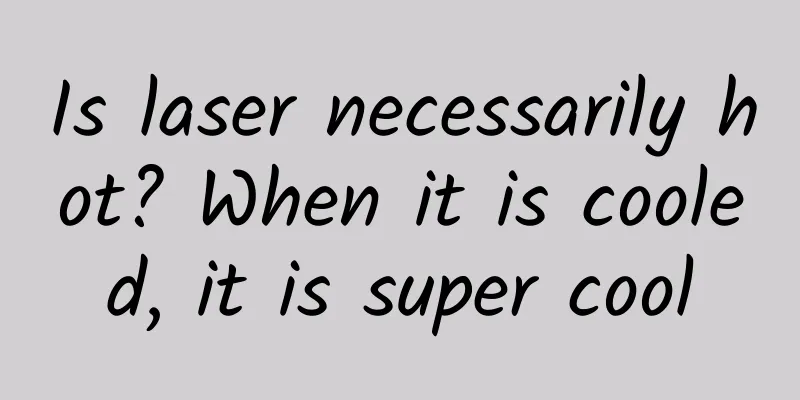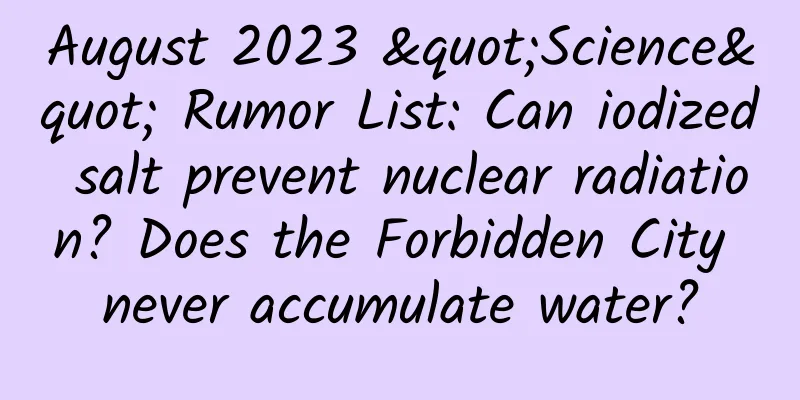Is laser necessarily hot? When it is cooled, it is super cool

|
Author: Li Wei (Institute of Plasma Physics, Hefei Institutes of Physical Science, Chinese Academy of Sciences) The article comes from the Science Academy official account (ID: kexuedayuan) —— Remember the laser guns in Star Wars and the Death Star super laser cannon that can destroy entire planets? Remember the phase weapons in Star Trek that can instantly vaporize enemies? And Superman, who was born with a pair of laser eyes that made villains daunt. Figure 1 Laser weapons appearing in the poster of Star Wars: The Force Awakens Figure 2 Superman with laser eyes (Source: Guokr.com) Lasers often appear as a powerful super weapon in these works. They almost all play the same role, which is to heat objects. But what exactly is a laser? How is it different from ordinary light? Can lasers only be used to heat things? Follow Dayuaner to become a "light chaser" and see the infinite secrets of the laser world~ Laser? What is it? In our daily life, we not only hear the word laser, but sometimes we also hear laser. So what are they? What is the difference between them? Those who don’t know much about it may interpret “laser” literally as the radiation emitted by radium, thus creating the misunderstanding that “laser” can harm people’s health. In fact, laser has nothing to do with radium. It is the transliteration of the English word LASER, which is taken from the first letters of the English words Light Amplification by Stimulated Emission of Radiation, meaning “light amplification by stimulated emission of radiation”. So what is "stimulated radiation"? It is based on a new theory proposed by the great scientist Einstein in 1917. This theory says that in the atoms that make up matter, there are different numbers of particles (electrons) distributed at different energy levels. When particles at high energy levels are stimulated by certain photons, they will jump (transition) from high energy levels to low energy levels. At this time, they will radiate light of the same nature as the light that stimulated it, and under certain conditions, a weak light can stimulate a strong light. This is called "light amplification by stimulated radiation". In Hong Kong, Macao and Taiwan, people usually call stimulated emitted light laser, while we call it laser according to Mr. Qian Xuesen's suggestion, which is a more appropriate translation. Therefore, laser and laser are the same thing. (To learn more about the secrets of lasers, please click: Academician talks to you about the past, present and future of lasers) Influenced by some science fiction movies, we all know that laser is a kind of light with strong energy. It has a thermal effect. A 300mW ordinary laser pen can ignite paper at close range. Laser hair removal and freckle removal are used in hospitals, and even laser welding of retinas is used. Strong lasers used in industry can penetrate hard steel plates. Even the hardest substance in the world - diamonds - can be cut and polished using lasers. Figure 3: Laser cutting machine is cutting steel plate (Source: Veer Gallery) This characteristic of lasers is used by scientists to study nuclear fusion. Scientists use multiple beams of strong lasers to simultaneously shoot at a fuel core filled with deuterium and tritium. Under the action of so many laser beams, the temperature of the fuel core can exceed 100 million degrees Celsius, which is five or six times higher than the temperature at the center of the sun. This is the highest temperature created by humans in the world. The pressure on the fuel core is 100 billion times the pressure of the Earth's atmosphere. The fuel core is ignited, and deuterium and tritium undergo nuclear fusion reaction, releasing huge energy. We can see that the above applications all take advantage of the high brightness and highly concentrated energy of lasers. But did you know that such "hot" lasers can also cool atoms to extremely low temperatures? This sounds incredible and goes against our intuition. Lasers have a trick to freeze atoms OK, before we explain how laser cooling works, we first need to know what “hot” means? Imagine that when we are taking a comfortable hot shower in the bathroom, a drop of cold water from the bathroom ceiling cannot withstand the influence of the earth's gravity and drops on you, which stimulates you severely. You can't help wondering why these water drops are not as hot as the water sprayed from the shower. What is the essence of "heat"? This question has troubled mankind for a long time. In the 18th century, a scientist named Lomonosov finally gave the answer: heat is the manifestation of the movement of molecules inside matter! Therefore, we can assume that the speed of the water molecules in the hot water sprayed from the shower is faster than the speed of the water molecules in the small water droplets on the bathroom ceiling. Figure 4 Water drops in the bathroom (Source: veer Gallery) After understanding the nature of the "heat" of an object, we also know how to "cool" it. As long as we slow down the movement speed of the molecules inside the object, we can achieve our goal. In fact, atoms and molecules are moving randomly and at high speeds all the time, and we hope that they can slow down, which is easy. Since they can't "brake", we can help them "brake". We just need to apply a force opposite to the direction of movement. But they are too small, so small that we can't catch them with our fingers and slow them down, so we need to find a pair of "little hands" to help us realize this wish. Whose “little hands” can help us? Scientists thought of "light". Huh? This idea doesn't seem to work, because scientists seem to be adding energy to the system to try to reduce the energy of the system, just like trying to blow out a candle with a flamethrower. Will this work? Figure 5 Blowing out candles with a flamethrower (Image source: self-made by the author) Of course it is useful, because light is very special. Although it has no mass (the rest mass of photons is zero), it has momentum. When a large number of photons shine on an object, it will produce a kind of pressure on the object. This pressure is called light pressure, which is the result of photons transferring momentum to the object. Solar sails use light pressure as thrust, and the tail of a comet always faces away from the sun, which is also affected by the light pressure of the sun. Therefore, using the light pressure of photons to slow down the moving atoms is a feasible method. If an atom is moving in one direction and hits a photon moving in the opposite direction, the momentum of the photon will be transferred to the atom, and the atom's movement speed will slow down. This is the key to laser cooling. We may have another question at this point. Once the atom slows down, won't it continue to be hit by more photons and accelerate in the opposite direction? Moreover, the movement of atoms is random. If the atoms and photons move in the same direction, won't the atoms move faster? This question makes a lot of sense. In fact, because atoms only absorb light of a specific wavelength, scientists make sure to adjust the laser wavelength to be just greater than the absorption wavelength of the atom when it is stationary. In this way, according to the Doppler effect, when the atom moves toward the photon, the wavelength of the light will be compressed. When the wavelength of the light is compressed to exactly equal the absorption wavelength of the atom, the atom will absorb the photon, the atom will transition from the ground state to the excited state, the atom's movement speed will slow down, and the kinetic energy will decrease; and when the atom stops or moves in the same direction as the photon, the atom will not absorb the photon. Figure 6 Schematic diagram of one-dimensional Doppler cooling (Image source: Reference [1]) So what if the atoms always move in all random directions, as always? This is easy to solve, we can add more lasers in another direction. If we also add lasers or mirrors on the top and bottom, front and back of the atom, we now have six directions of lasers to slow down an atom that may be moving in any combination of these six directions. Figure 7 Lasers in six directions are used to cool atoms (Image source: Image source: https://www.newelectronics.co.uk/) So how cold can we get with laser cooling? Well, scientists have lowered the temperature in the lab to 0.5nK, which is almost absolute zero (-273.15℃). However, we can never quite reach absolute zero due to Heisenberg's uncertainty principle, which states that we can never know both the position and momentum of a particle at the same time. Therefore, we can never truly stop the motion of an atom. The very low temperatures we achieve with laser cooling, such as cooling objects to almost absolute zero, are achieved by refrigerating very small objects. So why do we spend so much effort on laser cooling? The original reason is that if we want to accurately measure various atomic parameters, the best way is to cool the atoms to make them quiet (with the help of magnetic optical traps and other means) so that we can control and observe them. Now we have another reason: if we want to observe the quantum behavior of macroscopic objects, they must be kept in an extremely cold state. Applications of laser cooling Laser cooling has been widely used in the field of scientific research. It not only helps scientists observe the wavelengths of coherent matter waves, but also opens new research windows for scientists in the fields of precision measurement, quantum information, etc. A more down-to-earth application of this technology is "time". In the past, scientists used the characteristic that the transition energy levels of atomic hyperfine structures have very stable transition frequencies to develop atomic clocks with higher precision than crystal clocks, with an accuracy error of 1 second/3 million years. With the help of laser cooling technology, scientists can reduce the movement speed of cesium atoms and design cold atomic clocks, whose accuracy error can be reduced to 1 second/300 million years. The world's first space cold atomic clock carried by my country's Tiangong-2 is the most accurate clock in the world. It works with the Beidou satellite orbiting the earth to provide us with navigation and positioning accurate to the centimeter level. Figure 8 Space cold atomic clock (developed by Shanghai Institute of Optics and Fine Mechanics, photo taken by Zhao Kan) When we travel around the world on planes and cars that are cut and welded by lasers and guided by the Beidou navigation system, we should not forget that the lasers are indispensable behind this. Laser is really a good helper for scientists. It is not only hot, but also very COOL! References [1] Zhuang Wei, Li Tianchu. Laser cooling and manipulation of atoms: principles and applications[J]. Science and Technology Review, 2018, 36(05): 28-38. [2] Wang Yuzhu, Xu Zhen. Laser cooling and its application in science and technology [J]. Progress in Physics, 2005(04):347-358. [3] Ji Yang. Laser Refrigeration[J]. Physics Teaching, 2014, 36(10): 2-3. [4]http://www.kepu.net.cn/gb/technology/telecom/fiber/fbr301.html [5]https://mp.weixin.qq.com/s?__biz=MzI3MzE3OTI0Mw==&mid=2247484836&idx=1&sn=3d6c5accb9500f62942595820a2fe623&scene=38#wechat_redirect |
Recommend
Food is the most important thing for people. Are we eating right?
Author: Wang Fang, deputy director of the China R...
Polluting the environment? Destroying the ecology? Fertilizers feel wronged
Since the birth of the first chemical fertilizer,...
Can LeEco’s smartphone ecosystem continue to differentiate itself?
Recently, a high-definition spy photo of LeTV'...
Wrapped in 8 pieces of clothing and 2 layers of thick quilts, a five-month-old baby almost had an accident! The consequences of dressing like this in winter are very serious
The weather is getting colder Is everyone Have yo...
Kuaishou announces full-link support for HDR video, enabling HDR video creation and consumption
Recently, Kuaishou APP announced that it will pro...
Xiaohongshu KOL promotion: the secret of note ranking and weight algorithm!
Two months have passed since Xiaohongshu’s big pu...
World Book Day丨I know you’ve read history books, but what about “shitty books”?
Produced by: Science Popularization China Author:...
How to operate Wukong Q&A? Share 4 tips!
Last year, Wukong Q&A provided subsidies of 1...
The Centers for Disease Control and Prevention issued a reminder! These vegetables must be cooked thoroughly to prevent poisoning!
Summer is hot and rainy, and is a season when bac...
Six JavaScript frameworks worth paying attention to in the field of mobile development
Overview: As a mobile developer, are you still tr...
APP user operation: How to prevent users from changing their minds?
Preventing user churn and improving retention and...
How long do you have to be away from your phone before you get nervous? Maybe just a few minutes
How long could you go without your phone? Psychol...
Daily operation and promotion methods of new media operation accounts
When doing new media operations , most of the mea...
Black hole "foraging" live! How do stars become "spaghetti"?
Black holes turn stars into spaghetti: a cosmic c...
Beware! A new type of "epidemic investigation" scam is coming!
Editor's note: During the special period of e...









